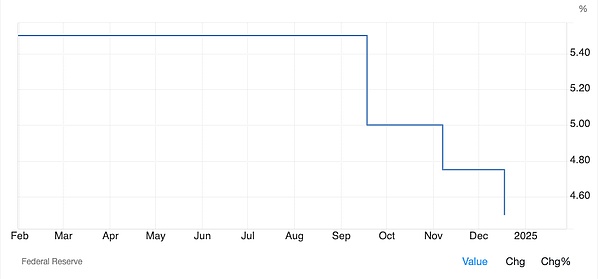
Source: Liu Jiaolian
After falling rapidly overnight on Thursday, BTC stabilized at 96k. The entire crypto market also defended tenaciously and temporarily stopped the decline.
Since September this year, the Federal Reserve has cut interest rates three times, cutting the federal funds rate by a cumulative 100bp, from 525-550 to 425-450.
Unusually, the 10-year U.S. bond yield also began to rise in September. By the end of the year, it had increased by nearly 100bp, from about 360 to about 460.
This is a local high in April and a historical high 17 years ago in 2007.
What happened in 2007 needs no introduction. That year, the subprime mortgage crisis began to spread in the United States and eventually triggered a financial crisis that swept the world. In 2008, Satoshi Nakamoto suddenly got inspiration and invented Bitcoin.
Now, the Federal Reserve has cut interest rates by 100bp, and U.S. bond yields have increased by 100bp. A serious departure. The Fed's interest rate controls appear to be out of control. The more interest rates are cut, the higher the market interest rate will be!
Friends who understand how the Federal Reserve conducts macro-interest rate control - in fact, to put it bluntly, it intervenes in market interest rates - should know that the Fed's interest rate increases and decreases cannot directly change market interest rates. , but through so-called open market operations to buy and sell U.S. debt, using the tool of U.S. debt to transmit interest rate adjustments to the market.
For example, there are two items in the executive minutes of the interest rate meeting in December 2024:
* Conduct a standing overnight repurchase agreement operation, the minimum bidding interest rate is 4.5%, the total operation The limit is $500 billion.
* Conduct standing overnight reverse repurchase agreement operations, providing an interest rate of 4.25%, and a single counterparty daily limit of US$160 billion. Setting this rate at the lower end of the federal funds rate target range is designed to support the effective implementation of currency and the smooth operation of short-term funding markets.
Bond yields and bond prices have an inverse relationship. This alone confuses many people.
If the Federal Reserve sells U.S. debt at an interest rate of 4.25% and collects U.S. debt at an interest rate of 4.5%, will it definitely be able to keep market interest rates stuck in the 425-450 range?
That’s not necessarily the case.
For example, before the interest rate cut in September 2024, the Fed's interest rate control range was still at a historical high of 525-550, but the interest rate in the U.S. bond market has dropped to a local low of 360, with a mid-range spread of nearly 2 percentage points.
What does this mean? This shows that the market is buying U.S. bonds like crazy, regardless of the fact that the Fed's "official price" is cheaper.
Of course, the Federal Reserve only conducts transactions with designated large banks, and ordinary people cannot directly participate at all.
Is the irrational market really bullish on U.S. bonds, or are retail investors being fooled by investment consultants into the game?
Jiao Lian still remembers that period when there were overwhelming posts on the Internet promoting U.S. debt and urging Lee to enter the market.
Looking back from the chart, the wave of public opinion guidance should be from May to September, corresponding to the decline in U.S. bond yields. By September, it was the end.
The market rushes ahead of expectations of interest rate cuts. What is the logic? In other words, what is sales rhetoric?
Jiaolian thought, it would probably be like this, boss, look, the Federal Reserve is about to start cutting interest rates, why don’t you buy some high-yield U.S. bonds to maintain and increase their value? There is no such store beyond this village. When the Federal Reserve lowers interest rates, only low-interest U.S. bonds can be purchased.
Unfortunately, the iron law of the financial market is always that if you make decisions based on other people's investment advice, you will either suffer a loss or be fooled.
The interest rate cut was implemented, and U.S. bonds plummeted. The frontrunner was buried.
What is the reason for being buried? The buried logic is also very simple, that is, the Fed cuts interest rates, the market risk on, that is, the so-called risk appetite increases, capital sells U.S. bonds to chase high-risk U.S. stocks, bonds fall and stocks rise, and U.S. bond yields rise instead of falling.
But think about it again, is it really true that all capital is driven by chicken blood and willing to allocate high-risk assets?
Or are you forced by the expected high inflation in the future?











